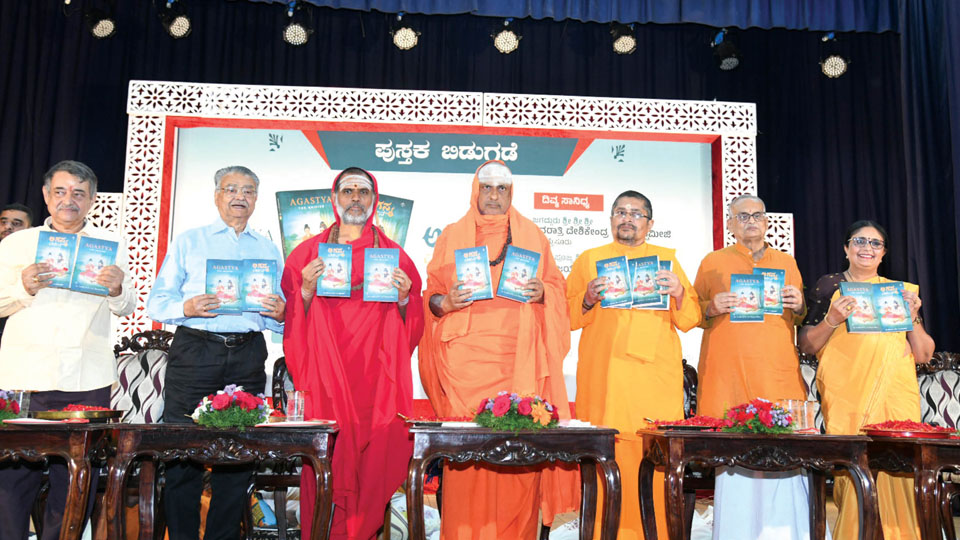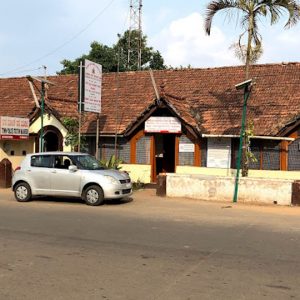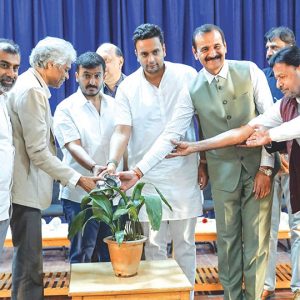‘Agastya: The Unifier’ and ‘Agastya Darshana,’ co-authored by Dr. M.N. Sudha and advocate O. Shama Bhat, released
Mysuru: A book on the sage, who bridged wisdom, warfare and worlds, ‘Agastya: The Unifier,’ co-authored by Dr. M.N. Sudha and noted advocate O. Shama Bhat, and its Kannada version ‘Agastya Darshana’ were released at an event held at JSS College of Arts, Science and Commerce on Ooty Road in Mysuru last evening.
The event was jointly organised by Sri Bramharshi Agastya Lopamudra Jnana Peeta, Mysuru and Ayodhya Publications, Bengaluru. Suttur Seer Sri Shivarathri Deshikendra Swamiji formally released the books.
Speaking about the books, Junior Pontiff of Avadhoota Datta Peetham Sri Datta Vijayananda Theertha Swamiji said that Indians, especially South Indians, and more so the people of Karnataka, must constantly remember Sage Agastya, who bestowed both knowledge and science upon the world.
He noted that through the scripture ‘Sri Vidya Deepika’, Sage Agastya imparted the power of mantras, tantra, the mind, intellect and scientific knowledge essential for society. The Swamiji also recalled that Sage Agastya was the first to carry India’s culture and traditions beyond the seas.
Evolution of intellect
The Swamiji stated that understanding Sage Agastya’s philosophy enables one to witness the transformation of the mind and the evolution of intellect. References to Sage Agastya can be found in the Vedas, some of the oldest scriptures and that his name appears in all the Puranas, he said.
Sri Datta Vijayananda Theertha Swamiji credited Agastya Maharshi for the prosperity and stability of South India today. He remarked that Sage Agastya, who built temples for many deities, also introduced the science of electricity to humanity.
He emphasised that the River Cauvery owes its existence to Sage Agastya. He explained that Agastya had two wives — Lopamudra and Cauvery — who are two forms of the same divine energy. Cauvery, the daughter of King Kavera, flows in the form of water because of Agastya’s grace.
He stressed that those living in the Cauvery region, drinking its water, worshipping Sri Ranganatha on its banks, and venerating Agastyeshwara Swamy by the river, must remember Sage Agastya every day. He also recounted the legend of River Cauvery’s origin.

Vishnu and Shiva temples
The Swamiji explained that it was Sage Agastya who established Vishnu temples on one bank of the River Cauvery and Shiva temples on the other. As a result, wherever there is a confluence of rivers, there are Sangameshwara temples, which have become a source of livelihood for many people.
He recounted an episode from Ramayana, where Lord Rama, despite repeatedly shooting arrows, was unable to slay Ravana. In this moment of struggle, Agastya Maharshi appeared as the true guiding guru and advised Rama to chant the ‘Aditya Hridaya Stotra’ (Surya Namaskara) and revealed the secret of targeting Ravana’s heart, where the pot of nectar (amrita kalasha) was hidden. Following Agastya’s guidance, Rama successfully vanquished Ravana.
Suttur Seer Sri Shivarathri Deshikendra Swamiji, in his address, highlighted that Sage Agastya, one of the seven great sages (Saptha Rishis), journeyed from the North to the South, symbolically bridging the two regions.
He noted that Agastya was not only instrumental in the origin of River Cauvery but also credited with laying the foundation for Karnataka’s classical music, making him the progenitor of musicians.

Origin of Govinda
The Swamiji praised the meaningfulness of the compiled information about the sage in the book.
He narrated a fascinating legend, explaining that the chant “Govinda… Govinda…” by those who climb the hill to Tirupati Balaji Temple owes its origin to Sage Agastya. He recounted that Sage Agastya once established a goshala (cow shelter), where Lord Vishnu appeared in person, asking for a cow. The sage promised to give the cow if Vishnu returned with his consort. Later, Lord Srinivasa and Goddess Padmavathi visited the goshala together, but Sage Agastya was not present. As the divine couple began to leave, Agastya arrived and followed them, intending to hand over the cow and calf. While calling out to the cow, he cried, “Go… inda,” which eventually became “Govinda,”
The event was presided over by V. Nagaraj, President of Mythic Society, Bengaluru. Brahmachari Prasadamirita Chaitanya of Mata Amritanandamayi Mutt, Star of Mysore and Mysuru Mithra Founder-Editor Dr. K.B. Ganapathy, Advocate & author O. Shama Bhat and author Dr. M.N. Sudha were also present.
Accessible to all
Agastya: The Unifier’ is a significant work that captures the life and legacy of Sage Agastya, who is an heir to India’s ashraya culture. While knowledge about Sage Agastya was once confined to scholars and the learned, this book makes his life story accessible to all. —Suttur Seer Sri Shivarathri Deshikendra Swamiji
Atheists are also believers
Even atheists, despite their claims, end up acknowledging divinity. When atheists hold meetings and later step outside, they often say, by God’s grace, it didn’t rain and the meeting went on well inadvertently invoking the divine.
Many so-called atheists practice Surya Namaskara, which in itself an act of devotion. Anyone who bows to the Sun is, in essence, a believer and this is what Sage Agastya taught us. Those who revere the Sun are destined for success. —Sri Datta Vijayananda Theertha Swamiji
Agastya took our culture beyond the seas
Sage Agastya was instrumental in spreading Indian culture beyond the seas. Agastya, who taught that everything originates from Shakti (divine energy), had mastered water purification techniques and imparted knowledge about metals.
Agastya’s contributions to Karnataka are countless and it is believed that he referred to the region as ‘Karinadu.’ In addition to making significant contributions to physics, Agastya introduced multiple languages and is regarded as the world’s first librarian. —O. Shama Bhat, Advocate and Author








Recent Comments